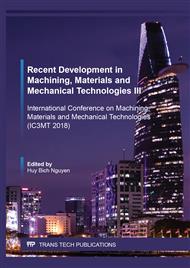p.56
p.62
p.71
p.77
p.84
p.92
p.99
p.106
p.114
Surface Characteristics with Curved Grinding of a Titanium Alloy with Coolant Supplied from the Inner Side of the Grinding Wheel
Abstract:
The objective of this paper is to clarify the effect of the difference of grinding fluid supply method on grinding surface characteristics during the curved surface machining of titanium alloy. The convex and concave type workpieces were machined by internal coolant supply and external coolant supply, and the surface characteristics were compared. The internal coolant supply could supply the grinding fluid directly to the machining point through the grinding wheel pores. One nozzle or seven nozzles were used for external coolant supply. As a result, the surface roughness of the concave surface decreased by about 10 % compared with the one nozzle was used when the grinding fluid was supplied from the inner side of the grinding wheel. In the case of the convex surface, the surface roughness decreased about 20 % compared with the single nozzle was used, and it decreased about 9 % compared with the seven nozzles were used.
Info:
Periodical:
Pages:
84-91
Citation:
Online since:
October 2019
Price:
Сopyright:
© 2019 Trans Tech Publications Ltd. All Rights Reserved
Share:
Citation:


